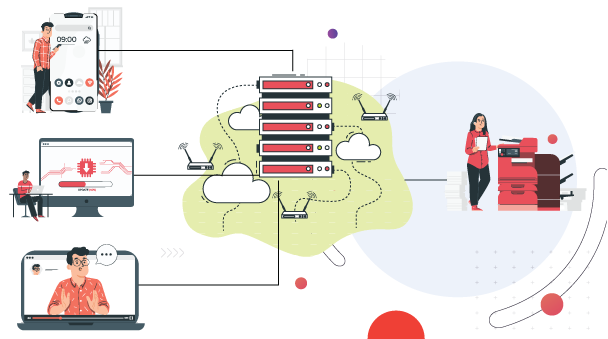Based on its IT architecture, industry domain, and specific requirements, every business needs to decide the configuration of its company-wide print environment. The decision on the configuration of the print infrastructure should be based on one’s ability to manage the installed print infrastructure and the form that is best suited for the business’ printing needs.
Many businesses, big and small, are now opting for cloud printing. These businesses view the adoption of the cloud print solution as an essential step in their digital transformation. Such businesses are making a move to the cloud from on-premise print servers – principally, to save on server costs and do away with the need to manage their print infrastructure. The final decision to opt for a central print server or a server-less cloud printing solution depends on the specific printing needs of the business.
Often, a managed print service provider with specialized knowledge of printing solutions can be a helpful partner for businesses to decide on the configuration of their print infrastructure. In addition, third-party business print services free up in-house resources to focus on core business functions.
What is a Print Server?
A print server is a special server that helps connect printers and client computers on a network. The print server receives and queues print jobs from the network’s client computers and directs these print jobs to suitable printers.
The print server also performs several secondary functions such as:
- Inspect the print jobs to be processed
- Reorder print jobs
- Delete print jobs
- Undertake accounting functions such as counting pages, etc.
- Enforce administrative policies such as color printing quotas, authentication of user/department, printed document watermarking, etc.
A networked computer may be configured as a print server and be connected to shared printers. Sometimes a printer may come with a built-in print server, and often print servers may also be integrated into a wireless router or a firewall.
Managing the Print Infrastructure
Even businesses with the resources – people and budget to maintain, support, and secure the print infrastructure – find it highly complicated and expensive. Managing the print infrastructure includes device configuration, driver installation, application deployment, etc., making it complex. Managing these activities with in-house resources presents businesses with the following internal challenges:
- Ambiguity over process ownership
- Handling print latency
- Dispersed hardware
- Multiple operating systems and devices
Increasingly, firms to relieve themselves of the need to bear the administrative overhead of managing the print infrastructure opt for managed print services. A managed print service provider takes care of and optimizes the business’ complete printing requirements. As a result, a managed print solutions vendor improves efficiencies, reduces costs, and manages printer utilization, problems, and end-user satisfaction.
Administering the Print Infrastructure with Print Servers
Employing a print server is the preferred option when
- There is a requirement for central control of print operations.
- The computational load needs to be transferred to a server.
- For network segmentation – the printer network is kept separate from the rest of the IT network – PCs, data servers, etc., for IT security.
- For exercising access control.
- Integration with enterprise applications such as CRM, ERP, etc.
The advantages of using print servers are many
- Print servers scale well as the businesses scale. New users can be added, group settings can be changed, and print permissions can be updated easily.
- Print servers are easy to set up and run. Software updates are easier to manage than updating each computer on the network.
- Print servers enable centralized print management. Centralized responsibility resting with the IT team rather than with scattered users reduces the frequency of user errors. It also allows the central administration of print policies.
- It is easier for end-users when they do not have to add printers and undertake periodic settings updates.
However, deploying print servers also carries some drawbacks
- Added costs related to hardware, software, operation, and maintenance.
- Due to the print data traffic flowing to and from the print server, increased WAN loads.
- In the event of a network failure, the possibility of offline printing is excluded.
5 Reasons to have a Print Server Installed on your Print Infrastructure
For a business that uses multiple printers and requires voluminous printing, having a print server installed as a part of the print infrastructure serves several useful functions:
- The print server can queue the print jobs for each printer and send the job to the printer that can print the fastest.
- The print server optimizes the utilization of the business’ print assets – improving operational efficiency and serving to optimize print management.
- It enables the management of printers from one central location. The central server also facilitates print reporting and auditing. It allows the business to track the utilization of money and resources and use the generated data to realign print policies suitably.
- When the printers are distributed across multiple locations/floors/buildings, the print server enables the reordering, printing, and deleting of print jobs at several different printers.
- Having a print server enables the central installation of software updates. IT personnel need not install software updates on each computer on the network.
We can help!
Print management can load a business’ IT workforce and distract them from critical core business activities. In the absence of a print server – decentralized control of the print infrastructure increases upfront hardware and software costs and also increases the frequency of workflow interruptions due to downtime. Print servers ease scaling up as the business grows.
Through WeP Solutions, we take care of all the printing, copying, and scanning requirements of businesses through our managed print services. As a result, businesses can hand over all their printing worries to us and focus on what matters the most – the business.
Click here to know how WeP’s managed print service can help you grow your business.

